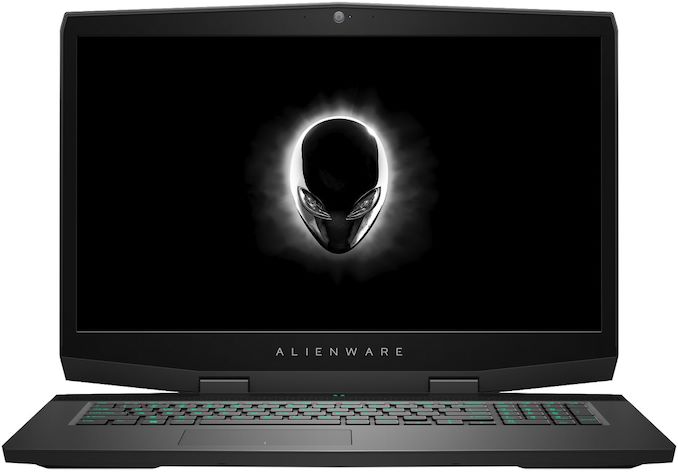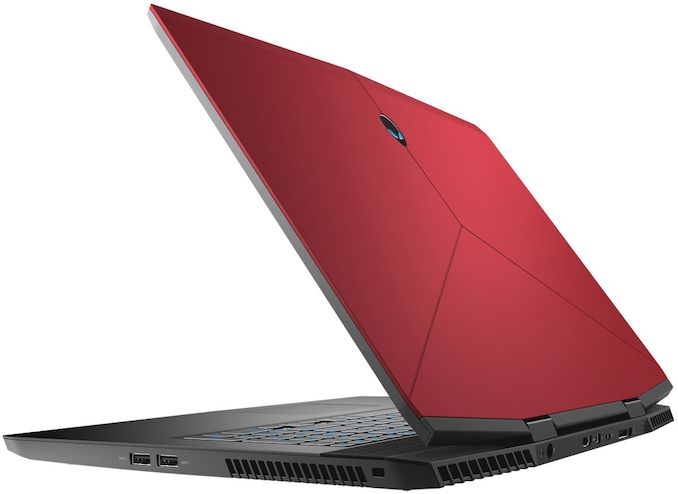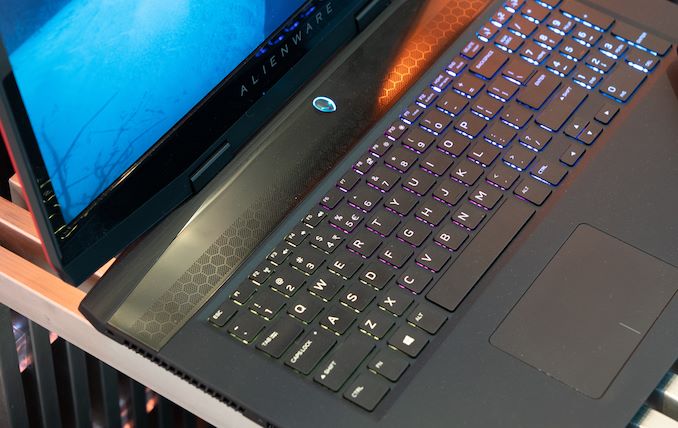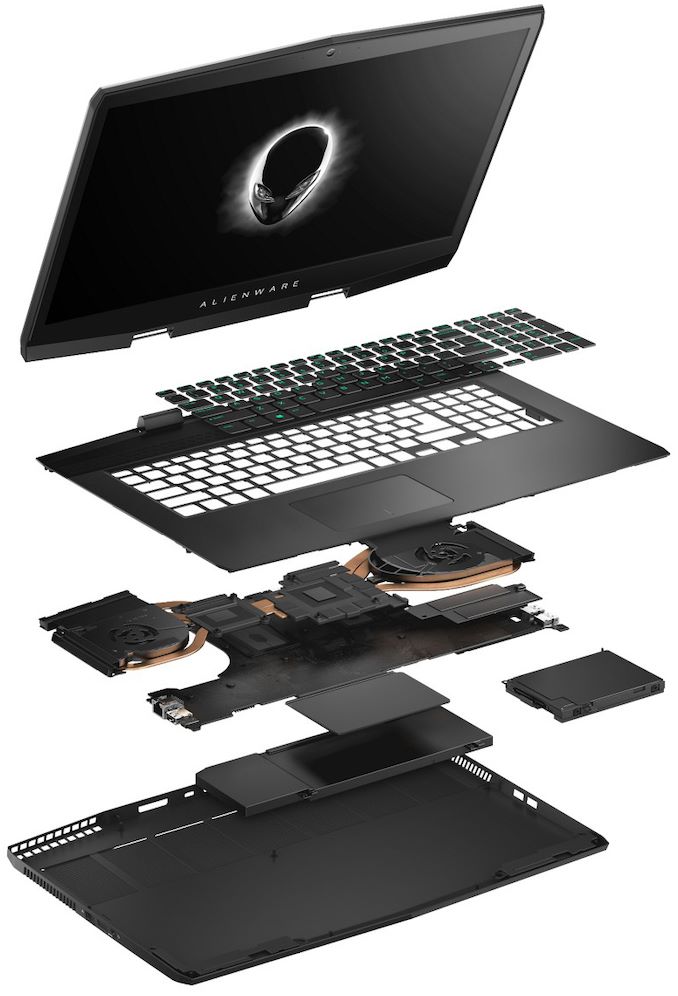Dell at CES 2019: Alienware m17 Packs Core i9, GeForce RTX into 17.3-Inch Chassis
by Anton Shilov on January 11, 2019 11:00 AM EST
Having launched Alienware m15 ultra-thin gaming laptops last year and updated them this week, Dell is rolling out more notebooks for gamers concerned about compact dimensions. The new Alienware m17 machines feature a 17.3-inch display and pack six-core processors paired with NVIDIA’s GeForce RTX 2080 Max-Q GPUs into a chassis that is up to 0.91 inch (23 mm) thick.
It goes without saying that the key feature of Alienware’s m17 laptop is its 17.3-inch display with a 1920×1080, 2560×1440, or 3840×2160 resolution. The Full-HD and Ultra-HD IPS panels feature a 60 Hz refresh rate, whereas the QHD TN panel features a 120 Hz refresh rate. Meanwhile, the higher-end 4K and QHD screens boast with 400 nits brightness, whereas the entry-level LCD is only rated for 300 nits brightness.
As far as internal hardware is concerned, the Alienware m17 notebook will use exactly the same components and configurations as the updated Alienware m15 introduced earlier this week. So, the the machine is powered by Intel’s latest mobile processor – including its six-core Core i9-8950HK CPUs – that are paired with NVIDIA’s GeForce GTX 1050 Ti, GeForce RTX 2060, RTX 2070 Max-Q, or 2080 Max-Q GPUs. Various Alienware m17 configs will feature from 8 to 32 GB of DDR4 memory and from 256 GB to 2 TB of PCIe/NVMe storage (see exact specs in the table below).
One important thing to note is that since the Alienware m17 notebook is bigger than the Alienware m15, it can be equipped with a larger and better cooling system. The latter enables the laptops to work at Turbo frequencies longer and thus provide higher performance in games.
When it comes to connectivity, the Alienware m17 copies its smaller brother too. The notebook has 802.11ac Wi-Fi + Bluetooth (from Qualcomm or Rivet Networks), a Killer E2500-enabled GbE port, one Thunderbolt 3 header, three USB 3.0 Type-A connectors, two display outputs (mini DisplayPort 1.3, HDMI 2.0), a 3.5-mm TRRS audio jack, and an Alienware Graphics Amplifier port for proprietary external graphics solutions. Besides, the Alienware m17 laptop features an RGB-backlit keyboard with a numpad, a 1080p webcam, stereo speakers, and a microphone array.
Just like the Alienware m15, the 17.3-inch notebook comes in Epic Silver or Nebula Red chassis that are from 18.5 to 23 mm thick (0.727 – 0.91 inches) thick. As for the weight, the Alienware m17 weighs 2.63 kilograms (5.79 pounds) when equipped with a 60 Wh battery or more when outfitted with a 90 Wh battery in a build-to-order configuration.
Sales of the Alienware m17 are set to begin on January 29, 2019. The price of the laptops will start at $1,650.
| General Specifications of Dell's Alienware m17 | ||||
| Alienware m17 1080p 60 Hz |
Alienware m17 1440p 120 Hz |
Alienware m17 4K UHD |
||
| Display | Type | IPS | TN | IPS |
| Resolution | 1920×1080 | 2560×1440 | 3840×2160 | |
| Brightness | 300 cd/m² | 400 cd/m² | ||
| Color Gamut | 72% NTSC (?) | ~100% sRGB | ||
| Refresh Rate | 60 Hz | 120 Hz | 60 Hz | |
| CPU | Intel Core i5-8300H - 4C/8T, 2.3 - 4 GHz, 8 MB cache, 45 W Intel Core i7-8750H - 6C/12T, 2.2 - 4.1 GHz, 9 MB cache, 45 W Intel Core i9-8950HK - 6C/12T, 2.9 - 4.5 GHz, 12 MB cache, 45 W |
|||
| Graphics | Integrated | UHD Graphics 620 (24 EUs) | ||
| Discrete | NVIDIA GeForce GTX 1050 Ti with 4 GB GDDR5 NVIDIA GeForce RTX 2060 with 6 GB GDDR6 NVIDIA GeForce RTX 2070 Max-Q with 6 GB GDDR6 NVIDIA GeForce RTX 2080 Max-Q with 8 GB GDDR6 |
|||
| RAM | 8 GB single-channel DDR4-2667 16 GB dual-channel DDR4-2667 32 GB dual-channel DDR4-2667 |
|||
| Storage | Single Drive | 256 GB PCIe M.2 SSD 512 GB PCIe M.2 SSD 1 TB PCIe M.2 SSD 1 TB HDD with 8 GB NAND cache |
||
| Dual Drive | 128 GB PCIe M.2 SSD + 1 TB (+8 GB SSHD) Hybrid Drive 256 GB PCIe M.2 SSD + 1 TB (+8 GB SSHD) Hybrid Drive 512 GB PCIe M.2 SSD + 1 TB (+8 GB SSHD) Hybrid Drive 1 TB PCIe M.2 SSD + 1 TB (+8 GB SSHD) Hybrid Drive 118 GB Intel Optane SSD + 1 TB (+8 GB SSHD) Hybrid Drive 256 GB PCIe M.2 SSD + 256 GB PCIe M.2 SSD 512 GB PCIe M.2 SSD + 512 GB PCIe M.2 SSD 1 TB PCIe M.2 SSD + 1 TB PCIe M.2 SSD |
|||
| Wi-Fi + Bluetooth | Default | Qualcomm QCA6174A 802.11ac 2x2 MU-MIMO Wi-Fi and Bluetooth 4.2 | ||
| Optional | Killer Wireless 1550 2x2 802.11ac and Bluetooth 5.0 | |||
| Thunderbolt | 1 × USB Type-C TB3 port | |||
| USB | 3 × USB 3.1 Gen 1 Type-A | |||
| Display Outputs | 1 × Mini DisplayPort 1.3 1 × HDMI 2.0 |
|||
| GbE | Killer E2500 GbE controller | |||
| Webcam | 1080p webcam | |||
| Other I/O | Microphone, stereo speakers, TRRS audio jack, trackpad, Alienware Graphics Amplifier port, etc. | |||
| Battery | Default | 60 Wh | ||
| Optional | 90 Wh | |||
| Dimensions | Thickness | 18.5 mm | 0.727 inch ~ 23 mm | 0.91 inch | ||
| Width | 410 mm | 16.1 inch | |||
| Depth | 292.5 mm | 11.52 inch | |||
| Weight (average) | 2.63 kilograms | 5.79 lbs | |||
| Operating System | Windows 10 or Windows 10 Pro | |||
Related Reading:
- Alienware Rolls Out Thin & Powerful m15 Laptop: Coffee Lake & GTX 1070 Plus 4K
- Eurocom Launches Tornado F7W DTR Laptop: Desktop Core i9-9900K with 128 GB of RAM
- Dell's Spring Range: New 8th Gen Alienware, Laptops, and Monitors
- Alienware Refreshes The Alienware 15 And 17 Gaming Notebooks At PAX
- Eurocom Launches Sky X4C, X7C and X9C Laptops with Core i7-8700K CPUs
Source: Dell















18 Comments
View All Comments
wr3zzz - Friday, January 11, 2019 - link
Ultrabook by definition needs to be "thin and light" otherwise it's just a regular notebook. The concept is mutually exclusive with the demands of gaming notebook. I don't think there is any technical limitation for others to make something like the LG Gram 17 but historically big firms don't see big enough market for thin and light 17" form factor to invest the resources into 17" ultrabooks.Personally I would like one as well. A 17" ultrabook would be quieter and more practical than 15" because of easier cooling and more space for ports. I think ultrabooks should be either 13/14" fanless or 17" with all the ports.
Spunjji - Monday, January 14, 2019 - link
I wouldn't place too much faith in how the cooling system looks. So far its stablemate the m15 tests surprisingly well when it comes to cooling, beating out the Razer Blade and even its own thicker Alienware cousin. If it's similar to that and just larger, it ought to cope very well indeed.Max-Q is binning + reduced clock speeds + reduced voltage. The relationship between clock speed, voltage and power is non-linear so (to a point) fairly moderate drops in clocks and voltages can produce a disproportionately large drop in TDP.
The problem is that in practice both Nvidia and OEMs use it as an excuse to price-gouge because these are "premium" products, and yeah, Nvidia's explanation of what they're actually doing is sorely lacking.
OP20 - Saturday, January 12, 2019 - link
Very ugly. Why cant they mature and put these specs in the design language of the xps 15. Lots of other people also feel this way but no one is making a gaming laptop for us.timecop1818 - Saturday, January 12, 2019 - link
Hey Dell is QCOM sucking your dick to include their garbage Ethernet and gaming WiFi garbage? What was wrong with Intel gbe and WiFi?plz stop supporting this snakeoil killer shit, I'll never buy another Dell until this stuff is removed
Opencg - Sunday, January 13, 2019 - link
Well you probably are just one of those idiots who assigns an ego to a brand and then goes with it. While killer has bad bad cards for sure, intel has some shit cards and major issues as well. In fact when I last did research and bought many wifi cards to get the best one it turned out to be killer. Best signal. Most consistent. Virtually the same via latency mon. Installed without killer driver suite. No issues. As well this is not only my opinion. At an in depth look on a forum the consensus was that the killer card was best due to signal.Spunjji - Monday, January 14, 2019 - link
This has been confirmed objectively via various review sites, too. Some people just want to talk shit.FXi - Sunday, January 13, 2019 - link
I like it as having a bit more cooling power, bit more screen real estate and not much more weight and size than the M15. I think the design works and brings the AW line closer to the popular designs of the XPS series. I agree cooling suffers but they've made a lot of ground up by going dimensionally deeper. I'd bet if people looked at the real internal surface area of the coolers they'd find it's not as different from the older thicker series as you'd think. They were taller but the fins were shorter in depth. And when we go to 10nm you may not even note the thinner design as much of an issue anymore. Look at all the 2in1's toting 2-4Ghz quad cores.What would really do this some good would be a 17" OLED panel to match with the 15.6 going in the M15. OLED has issues but the benefits in pixel response (better than a blinking backlight) to reduce blurring, along with greatly improved visuals and HDR that no longer needs a 500W backlight driven through LCD, would highly offset the negatives. Of course you'd need Samsung to supply such an OLED panel (LG hasn't been interested yet). If I had OLED and a 9th gen CPU, along with a 2070 or 80, it'd be on my ordering list. For now this is a good design step and little visual cues that people do and do not like can be addressed. Cooling will be better than the M15. I think many end users will be pleased. And it weighs half of what 17" gaming laptops did a short number of years ago.
Altagon - Tuesday, January 15, 2019 - link
Nice workstation, I am concern about a price tag ...